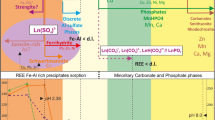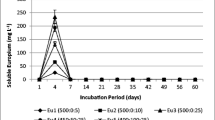Abstract
The following study is carried out in a mine of Mexico where acid drainage is produced. At the site, two types of rock which contain calcite are present, graphitic phyllite and limestone, and their use is proposed in a treatment system. Acid drainage contains dissolved Al, Cd, Cu, Fe, Mn and Zn, as well as high concentration of sulphates. By means of shaking tests conducted using flasks, the efficiency of the proposed two-step treatment was evaluated, first using phyllite to remove Fe and Al and then limestone to remove Cu, Cd, Mn and Zn. During the tests performed using phyllite, a pH = 6.00–6.16 was reached, and 100% of Al, Fe and Cu was removed. During the second step, using limestone, a pH = 7.77–8.39 was achieved and 100% of Cd, 95–99% of Zn and 74–89% of Mn were removed. Sediment characterization indicates that Al and Fe precipitate as hydroxysulphates, Cu removal mainly occurs by sorption in iron hydroxysulphates, while Cd, Mn and Zn are mostly removed by adsorption in clay phases formed by alteration of phyllosilicates contained in rock.






Similar content being viewed by others
References
Acero P, Ayora C, Torrentó C, Nieto J (2006) The behavior of trace elements during schwertmannite precipitation and subsequent transformation into goethite and jarosite. Geochim Cosmochim Acta 70:4130–4139
Acero P, Hudson-Edwards K, Gale J (2015) Influence of pH and temperature on alunite dissolution: rates, products and insights on mechanisms from atomistic simulation. Chem Geol 419:1–9
Alfonso P, Torró L, Canet C, Parcerisa D, García-Vallés M, Mata-Perelló J, Mesa C, González-Partida E (2011) Mineralogía del yacimiento VMS de Zn-Cu-Pb-Ag-Au de Tizapa, México. Macla 15:27–28
Appelo C, Postma D (2005) Geochemistry, groundwater and pollution, 2nd edn. Balkema Publishers, Amsterdam
Blowes D, Ptacek C, Jambor J, Weisener C (2004) The geochemistry of acid mine drainage. In: Holland H, Turekian K (eds) Treatise of geochemistry. Elsevier, Oxford, pp 149–204
Conagua (2008) Determinación de la disponibilidad de agua en el acuífero 1509 Temascaltepec, Estado de México. Comisión Nacional del Agua, Ciudad de Mexico
Cravotta C, Trahan M (1999) Limestone drains to increase pH and remove dissolved metals from acidic mine drainage. Appl Geochem 14:581–606
Equeenuddin SM, Tripathy S, Sahoo P, Panigrahi M (2010) Hydrogeochemical characteristics of acid mine drainage and water pollution at Makum Coalfield, India. J Geochem Explor 105:75–82
Faure G (1998) Principles and applications of Geochemistry, 2nd edn. Prentice Hall, Upper Saddle River
Filipek L, Hatton G, Gusek J, Tsukamoto T (2003) Passive treatment of acid rock drainage (ARD): state of the practice. Tailings and mine waste’03. Balkeman Publishers, Netherlands, pp 293–303
Gazea B, Adam K, Kontopoulus A (1996) A review of passive systems for the treatment of acid mine drainage. Miner Eng 9(1):23–42
Grande J, de la Torre ML, Cerón JC, Beltrán R, Gómez T (2010) Overall hydrochemical characterization of the Iberian Pyrite Belt. Main acid mine drainage-generating sources (Huelva, SW Spain). J Hydrol 390:123–130
Gu X, Evans L (2007) Modelling the adsorption of Cd(II), Cu(II), Ni(II), Pb(II), and Zn(II) onto Fithian illite. J Colloid Interface Sci 307:317–325
He M, Wang Z, Tang H (1997) Spatial and temporal patterns of acidity and heavy metals in predicting the potential for ecological impact on the Le An river polluted by acid mine drainage. Sci Total Environ 206:67–77
Holmström H, Öhlander B (2001) Layers rich in Fe and Mn oxyhydroxides formed at the tailings-pond water interface, a possible trap for trace metals in flooded mine tailings. J Geochem Explor 74:189–203
Johnson D, Hallberg K (2005) Acid mine drainage remediation options: a review. Sci Total Environ 338:3–14
Jones A, Collins R, Waite T (2011) Mineral species control of aluminium solubility in sulfate-rich acidic waters. Geochim Cosmochim Acta 75:965–977
Komnitsas K, Bartzas G, Paspaliaris I (2004) Efficiency of limestone and red mud barriers: laboratory column studies. Miner Eng 17:183–194
Kosmulski M (2009) Surface charging and points of zero charge. CRC Press, Boca Raton
Labastida I, Armienta MA, Lara-Castro RH, Aguayo A, Cruz O, Ceniceros N (2013) Treatment of mining acidic leachates with indigenous limestone, Zimapan Mexico. J Hazard Mater 262:1187–1195
Langmuir D (1997) Aqueous environmental geochemistry. Prentice Hall, Upper Saddle River
Lawrence R, Wang Y (1997) Determination of neutralization potential in the prediction of acid rock drainage. Proc Int Conf Acid Rock Drain 1:451–464
Lee G, Bigham J, Faure G (2002) Removal of trace metals by coprecipitation with Fe, Al and Mn from natural waters contaminated with acid mine drainage in the Ducktown Mining District, Tennessee. Appl Geochem 17:569–581
Lei L, Song C, Xie X, Li Y, Wang F (2010) Acid mine drainage and heavy metal contamination in groundwater of metal sulfide mine at arid territory (BS mine, Western Australia). Trans Nonferrous Met Soc China 20:1488–1493
López P, Aduvire O, Barettino D (2002) Tratamientos pasivos de drenajes ácidos de mina: estado actual y perspectivas de futuro. Boletín geológico y minero 113(1):3–21
Lottermoser B (2007) Mine wastes. Characterization, treatment and environmental impacts, 2nd edn. Springer, Berlin
Luan F, Santelli C, Hansel C, Burgos W (2012) Defining manganese (II) removal processes in passive coal mine drainage treatment systems through laboratory incubation experiments. Appl Geochem 27:1567–1578
Miller A, Figueroa L, Wildeman T (2011) Zinc and nickel removal in simulated limestone treatment of mining influenced water. Appl Geochem 26:125–132
Nieto J, Sarmiento AM, Olías O, Canovas CR, Riba I, Kalman J, Delvalls TA (2007) Acid mine drainage pollution in the Tinto and Odiel rivers (Iberian Pyrite Belt, SW Spain) and bioavailability of the transported metals to the Huelva Estuary. Environ Int 33:445–455
Nordstrom D (1982) The effect of sulfate on aluminium concentrations in natural waters: some stability relations in the system Al2O3-SO3-H2O at 298K. Geochim Cosmochim Acta 46:681–692
Nuttall C, Younger P (2000) Zinc removal from hard, circum-neutral mine waters using a novel closed-bed limestone reactor. Water Resour 34(4):1262–1268
Romero F, Armienta M, González-Hernández G (2007) Solid-phase control on the mobility of potentially toxic elements in an abandoned lead/zinc mine tailings impoundment, Taxco, Mexico. Appl Geochem 22:109–127
Romero FM, Núñez L, Gutiérrez ME, Armienta MA, Ceniceros-Gómez AE (2011) Evaluation of the potential of indigenous calcareous shale for neutralization and removal of arsenic and heavy metals from acid mine drainage in the Taxco mining area, Mexico. Arch Environ Contam Toxicol 60:191–203
Sánchez J, López E, Santofimia E, Aduvire O, Reyes J, Barettino D (2005) Acid mine drainage in the Iberian Pyrite Belt (Odiel river watershed, Huelva, SW Spain): geochemistry, mineralogy and environmental implications. Appl Geochem 20:1320–1356
Sánchez J, Yusta I, Burgos W (2016) Geochemistry of dissolved aluminium at low pH: hydrobasaluminite formation and interaction with trace metals, silica and microbial cells under anoxic conditions. Chem Geol 441:124–137
Santomartino S, Webb J (2007) Estimating the longevity of limestone drains in treating acid mine drainage containing high concentrations of iron. Appl Geochem 22:2344–2361
SAP (2011) Minera Tizapa. de C.V., Estado de México. Servicios Administrativos Peñoles, División Minas, Mexico, S.A
Sarmiento AM, Olías M, Nieto JM, Cánovas CR, Delgado J (2009) Natural attenuation processes in two water reservoirs receiving acid mine drainage. Sci Total Environ 407:2051–2062
Silva AM, Cruz FLS, Lima RMF, Teixeira MC, Leao VA (2010) Manganese and limestone interactions during mine water treatment. J Hazard Mater 181:514–520
Silva M, Cunha E, Silva F, Leao V (2012) Treatment of high-manganese mine water with limestone and sodium carbonate. J Clean Prod 29–30:11–19
Simón M, Martín F, García I, Bouza P, Dorronsoro C, Aguilar J (2005) Interaction of limestone grains and acidic solutions from the oxidation of pyrite tailings. Environ Pollut 135:65–72
SSA (2000) Norma official Mexicana NOM-127-SSA1-1994 “Salud ambiental. Agua para uso y consumo humano. Límites permisibles de calidad y tratamientos a que debe someterse el agua para su potabilización”. In: Diario Oficial de la Federación 22 noviembre, pp 48–55
Turan G, Elevli S, Mesci B (2011) Adsorption of copper and zinc ions on illite: determination of the optimal conditions by the statistical design of experiments. Appl Clay Sci 52:392–399
Uwamariya V, Petrusevski B, Lens P, Amy G (2016) Effect of pH and calcium on the adsorptive removal of cadmium and copper by iron oxide-coated sand and granular ferric hydroxide. J Environ Eng 142:1–9
Younger PL, Banwart SA, Hedin RS (2002) Mine water hydrology, pollution, remediation. Kluwer Academic Publishers, Dordrecht
Zachara J, Cowan C, Resch C (1991) Sorption of divalent metals on calcite. Geochim Cosmochim Acta 55:1549–1562
Ziemkiewicz PF, Skousen JG, Brant DL, Sterner PL, Lovett RJ (1997) Acid mine drainage treatment with armored limestone in open limestone channels. J Environ Qual 26(4):1017–1024
Acknowledgements
This research project was carried out with the aid of the Support Program for Research Projects and Technological Innovation (PAPIIT IN 114113) of the National Autonomous University of Mexico (UNAM). The authors wish to thank Minera Tizapa, S.A. de C.V. for their interest and facilities provided, to Fabiola Vega and Maria Teresa Pi Puig from the Institute of Geology of UNAM and Guadalupe Contreras Ordaz from the Faculty of Engineering of UNAM, for their laboratory assistance. We also thank the reviewers for their suggestions and comments that greatly enriched the final version of this article.
Author information
Authors and Affiliations
Corresponding author
Rights and permissions
About this article
Cite this article
Santos Jallath, J.E., Romero, F.M., Iturbe Argüelles, R. et al. Acid drainage neutralization and trace metals removal by a two-step system with carbonated rocks, Estado de Mexico, Mexico. Environ Earth Sci 77, 86 (2018). https://doi.org/10.1007/s12665-018-7248-2
Received:
Accepted:
Published:
DOI: https://doi.org/10.1007/s12665-018-7248-2




